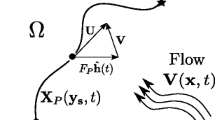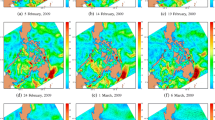Abstract
Autonomous surface and underwater vehicles (ASVs and AUVs) used for ocean monitoring are typically deployed for long periods of time and must operate with limited energy budgets. Coupled with the increased accessibility to ocean flow data, there has been a significant interest in developing energy efficient motion plans for these vehicles that leverage the dynamics of the surrounding flow. In this paper, we present a graph search based method to plan time and energy optimal paths in static and time-varying flow fields. We also use tools from topological path planning to generate optimal paths in different homotopy classes to facilitate simultaneous exploration of the environment by multi-robot teams. The proposed strategy is validated using analytical flow models, actual ocean data, and in experiments using an indoor laboratory testbed capable of creating flows with ocean-like features. We also present an alternative approach using a Riemannian metric based approximation for the cost functions in the static flow case for computing time and energy optimal paths. The Riemannian approximation results in smoother trajectories in contrast to the graph based strategy while requiring less computational time.






















Similar content being viewed by others
References
Bhattacharya, S., & Ghrist, R. (2015). Path homotopy invariants and their application to optimal trajectory planning. In Proceedings of IMA conference on mathematics of robotics (IMAMR), St Anne’s College, University of Oxford, September 9–11, 2015.
Bhattacharya, S., Likhachev, M., & Kumar, V. (2012). Topological constraints in search-based robot path planning. Autonomous Robots, 33(3), 273–290. https://doi.org/10.1007/s10514-012-9304-1. ISSN 0929-5593.
Bhattacharya, S., Kim, S., Heidarsson, H., Sukhatme, G., & Kumar, V. (2015). A topological approach to using cables to separate and manipulate sets of objects. International Journal of Robotics Research, 34(6), 799–815. https://doi.org/10.1177/0278364914562236.
Caron, D., Stauffer, B., Moorthi, S., Singh, A., Batalin, M., Graham, E., et al. (2008). Macro- to fine-scale spatial and temporal distributions and dynamics of phytoplankton and their environmental driving forces in a small subalpine lake in southern california, usa. Journal of. Limnology and Oceanography, 53(5), 2333–2349.
Chakrabarty, A., & Langelaan, J. (June 2013). Uav flight path planning in time varying complex wind-fields. In 2013 American control conference, pp. 2568–2574. https://doi.org/10.1109/ACC.2013.6580221.
CORDC. Naitonal HF RADAR network—surface currents. URL http://cordc.ucsd.edu/projects/mapping/maps/.
Cormen, T. H., Leiserson, C. E., Rivest, R. L., & Stein, C. (2001). Introduction to algorithms (2nd ed.). Cambridge: MIT Press.
Eichhorn, M. (2015). Optimal routing strategies for autonomous underwater vehicles in time-varying environment. Robotics and Autonomous Systems, 67, 33–43.
Fiorelli, E., Leonard, N. E., Bhatta, P., Paley, D. A., Bachmayer, R., & Fratantoni, D. M. (2006). Multi-AUV control and adaptive sampling in monterey bay. IEEE Journal of Oceanic Engineering, 31(4), 935–948. https://doi.org/10.1109/JOE.2006.880429. ISSN 0364-9059.
Garau, B., Alvarez, A., & Oliver, G. (2005, April). Path planning of autonomous underwater vehicles in current fields with complex spatial variability: an a* approach. In Proceedings of the 2005 IEEE international conference on robotics and automation, 2005. ICRA 2005, pp. 194–198. https://doi.org/10.1109/ROBOT.2005.1570118.
Huynh, V., Dunbabin, M., & Smith, R. (2015). Predictive motion planning for auvs subject to strong time-varying currents and forecasting uncertainties. In 2015 IEEE international conference on robotics and automation (ICRA), pp. 1144–1151. https://doi.org/10.1109/ICRA.2015.7139335.
Kim, S., Bhattacharya, S., Ghrist, R., & Kumar, V. (2013). Topological exploration of unknown and partially known environments. In Proceedings of the IEEE/RSJ international conference on intelligent robots and systems (IROS), Tokyo, Japan, November 3–7, 2013.
Kim, S., Bhattacharya, S., & Kumar, V. (2014). Path planning for a tethered mobile robot. In Proceedings of IEEE international conference on robotics and automation (ICRA), Hong Kong, China, May 31–June 7 2014.
Koay, T.-B., Chitre, M. (2013). Energy-efficient path planning for fully propelled auvs in congested coastal waters. In OCEANS-Bergen, 2013 MTS/IEEE, pp. 1–9. https://doi.org/10.1109/OCEANS-Bergen.2013.6608168.
Kruger, D., Stolkin, R., Blum, A., & Briganti, J. (April 2007). Optimal auv path planning for extended missions in complex, fast-flowing estuarine environments. In 2007 IEEE international conference on robotics and automation, pp. 4265–4270. https://doi.org/10.1109/ROBOT.2007.364135.
Kularatne, D., Bhattacharya, S., & Hsieh, M. A. (2016, June). Time and energy optimal path planning in general flows. In Proceedings of robotics: Science and systems, AnnArbor, Michigan. https://doi.org/10.15607/RSS.2016.XII.047.
Lolla, T., Ueckermann, M. P., Haley, P., & Lermusiaux, P. F. J. (2012, May). Path planning in time dependent flow fields using level set methods. In Proceedings of the IEEE international conference on robotics and automation, Minneapolis, MN, USA.
Lolla, T., Jr H, P., & Lermusiaux, P. (2015). Path planning in multi-scale ocean flows: Coordination and dynamic obstacles. Ocean Modelling, 94, 46–66. https://doi.org/10.1016/j.ocemod.2015.07.013. ISSN 1463-5003.
Lolla, T., Lermusiaux, P. F. J., Ueckermann, M. P., & Haley, P. J. (2014). Time-optimal path planning in dynamic flows using level set equations: theory and schemes. Ocean Dynamics, 64(10), 1373–1397. ISSN 1616-7228.
Otte, M., Silva, W., & Frew, E. (2016, May). Any-time path-planning: Time-varying wind field + moving obstacles. In 2016 IEEE international conference on robotics and automation (ICRA), pp. 2575–2582. https://doi.org/10.1109/ICRA.2016.7487414.
Petersen, P. (2006). Riemannian Geometry. Graduate Texts in Mathematics. Springer, ISBN 9780387294032.
Rao, D., & Williams, S. B. (2009). Large-scale path planning for underwater gliders in ocean currents. In Australasian conference on robotics and automation (ACRA), Sydney.
SCCOOS. Regional ocean model system (roms) model output. URL http://www.sccoos.org/data/roms-3km/.
Smith, R. N., Das, J., Heidarsson, H., Pereira, A., Cetinić, I., Darjany, L., et al. (2010). USC CINAPS builds bridges: Observing and monitoring the Southern California Bight. IEEE Robotics and Automation Magazine, Special Issue on Marine Robotics Systems, 17(1), 20–30.
Subramani, D. N., & Lermusiaux, P. F. (2016). Energy-optimal path planning by stochastic dynamically orthogonal level-set optimization. Ocean Modelling, 100, 57–77.
Veronis, G. (1966). Wind-driven ocean circulation, part i and part ii. Deep-Sea Research, 13(31), 17–29.
Witt, J., & Dunbabin, M. (2008). Go with the flow: Optimal auv path planning in coastal environments. In Australasian conference on robotics and automation (ACRA).
Funding
This study was funded by the National Science Foundation (Grant Numbers IIS-1253917 and CMMI-1462825).
Author information
Authors and Affiliations
Corresponding author
Ethics declarations
Conflict of interest
The authors declare that they have no conflict of interest.
Additional information
Publisher's Note
Springer Nature remains neutral with regard to jurisdictional claims in published maps and institutional affiliations.
This is one of several papers published in Autonomous Robots comprising the “Special Issue on Robotics Science and Systems”.
This work was supported by the National Science Foundation (NSF) Grants IIS-1253917 and CMMI-1462825.
Rights and permissions
About this article
Cite this article
Kularatne, D., Bhattacharya, S. & Hsieh, M.A. Going with the flow: a graph based approach to optimal path planning in general flows. Auton Robot 42, 1369–1387 (2018). https://doi.org/10.1007/s10514-018-9741-6
Received:
Accepted:
Published:
Issue Date:
DOI: https://doi.org/10.1007/s10514-018-9741-6




